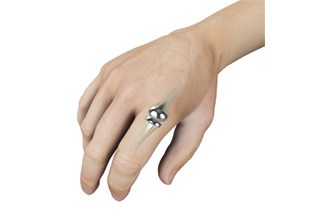What is a Finger Joint Implant?

A finger joint implant is an artificial joint made of metal, plastic, or pyrocarbon components that are used to replace a severely arthritic or injured finger joint. Finger implant surgery is a motion-preserving alternative to finger joint fusion surgery.
Anatomy
The hands are made up of 27 bones which are grouped into carpals, metacarpals, and phalanges. Each bone is separated by the articular cartilage, which helps in a smooth gliding movement of the fingers. Arthritis develops when the cartilage wears-out, resulting in pain, stiffness, and inflammation in the joints. Arthritis can affect any joint in the body, but the most commonly affected joints are the small joints of the fingers.
Indications for Finger Joint Implant
A finger joint implant may be indicated if the finger is painful, unstable, and has a limited range of motion due to arthritis, injury, or post-fracture deformation.
Preparation for Finger Joint Implant
Your doctor will assess your symptoms and perform an examination. Imaging tests such as X-ray, MRI, or CT-scanning may be ordered. Inform your doctor about the medicines you are taking prior to the procedure, and if you are allergic to any medicines or anesthesia. Arrange for someone to drive you home after the surgery.
Finger Joint Implant Surgery Procedure
- Either general or regional anesthesia can be used for the surgery.
- A surgical incision is made on the skin over the back of the finger joint.
- The underlying soft tissues are separated using a retractor.
- The joint capsule is incised to expose the finger joint.
- The ends of the bones forming the joint surfaces are excised.
- A cutting tool is used to reshape the bones to receive the implant.
- The finger joint implant is fitted in place.
- A strip of the tendon may be used to wrap the joint for additional stability.
- The incision is closed in layers.
- The finger is placed in a splint and bandaged with a padded dressing.
Recovery after Finger Joint Implant Surgery
Prescription pain medicines or NSAIDs (non-steroidal anti-inflammatory drugs) are used to manage pain. The splint will hold the finger in the correct position while healing. Keep the hand elevated as much as possible for the first few weeks. Stitches will be removed after 10-14 days. You will be recommended to work with an occupational therapist to regain mobility and strength in the finger.
Risks of Finger Joint Implant Surgery
As with any surgery, there are associated risks and complications that may occur. Those related to finger joint implant surgery may include:
- Anesthetic complications
- Infection
- Loss of sensation
- Stiffness
- Delayed healing or failure to heal
Benefits of Finger Joint Implant Surgery
Most patients that have undergone finger joint implant surgery report significant relief of painful symptoms and improvement in finger function.




